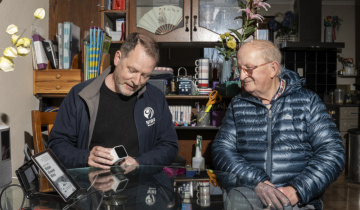The quest for cleaner wood burner emissions
During winter wood burners contribute significantly to urban air pollution – possibly more than motor vehicles.
NIWA undertook a home heating study in winter 2011 to find out which aspects of wood burners lead to high pollution, address air quality management issues and provide information for strategies to minimize the amount of harmful emissions.
NIWA, Environment Canterbury (ECan) and Auckland Regional Council are working on this project.
The study aims to answer:
- Why do people light their fires when they do?
- How long is each burn?
- How much wood is burned?
- How much pollution is discharged for these types of burners, and when?
- What conditions cause the emission of unusually high levels of pollution?
Starting at the beginning, Trees use the sun's energy for photosynthesis and we use the wood from the trees as a convenient energy-storage medium. When we place firewood in a wood burner we want to convert that stored energy into useable heat. We want the conversion to be efficient, to retrieve as much of the stored energy as we can and waste as little heat as possible.
Measuring the emissions alone gives us only part of the story. It tells us about the type and amount of pollution, but not about the causes.
We need to know why people light their fires, what goes in, what comes out and how much useable heat we get. Only then can we understand how the system works end-to-end.
We measure what goes in
We need to know the amount and rate at which wood is being burnt. To do this the wood is continuously weighed on an electronic scale. A Neon data logger records the decrease in weight as each piece is removed for burning.
Some types of wood contain more stored energy than others so generate more heat. The moisture content in wood can vary widely which affects burn quality, so we send wood samples to a lab to establish its density and moisture content first.
We measure what comes out
We measure what comes out, using complex sampling equipment developed by the Australian Commonwealth Scientific and Industrial Research Organization (CSIRO).
This controls the processes which measure:
- concentration of emitted particles
- concentration of emitted gases
- temperature of exhaust gases in the flue
- the rate at which gases are exhausted through the flue.
We record conditions in the room
We continuously record:
- air temperature
- humidity
- concentration of particles
- concentration of nitrous oxide (NO2)
The room temperature can provide information about the rate of heat loss. To maintain a stable room temperature it's necessary to replace the heat energy only as it's lost.
We measure the exhaust gases from the flue
A section is attached to the flue, which is connected to a 'blue box measurement system' on the ground via a conduit that protects the tubes and wires. A sampling tube is fitted inside the flue to enable us to extract a portion of the exhaust gases for sampling. A continuous flow of heated dry air is pumped through a jet near the top of this tube to draw a sample of exhaust gas out through the sampling tube, at the same time mixing and diluting it with the pumped air. The particles and gas samples can then be extracted from this diluted gas.
The sample stream is split two ways: a gas stream used to measure gas concentration and a particle stream used to measure particle concentration. The gas stream passes through a toxicology filter and on through an electronic gas measurement system where Carbon Monoxide (CO) and Carbon Dioxide (CO2) concentrations are separately continuously recorded. The filter is analysed later in a laboratory, for traces of toxic chemicals.
The particle stream is split several ways: one stream passes through an electronic PM2.5 particle counter connected to the recorder, while the others pass through filters to capture combustion particles. PM2.5s are about 1/100th the diameter of a human hair and are a health concern as they are easily trapped in the lungs. The particle filters are periodically weighed in a laboratory to determine the average particle concentration over the sampling period. This information is then used to calibrate the electronic particle counter.
To protect the in-line components, combustion condensates are removed at the bottom of the conduit before the gases enter the blue box.
The temperature and flow rate of exhaust gases in the flue are recorded. To derive the flow rate we measure the pressure on a calibrated plate positioned in the flue. We sense the flue temperature, typically 250 degrees C, with two high-temperature thermocouple devices.
The challenge
To extract the energy from the wood, while keeping the emissions as low as possible.
Burning wood doesn't add any new carbon to the atmosphere since trees use carbon dioxide to grow. The carbon just recycles. However log burning does add unwanted particulates (fine particles) and gases to the air. These can affect health by introducing toxic chemicals to the body via the lungs and by reducing lung capacity.
In practice this is likely to be through a combination of approaches, such as: better wood burner design, guidelines for wood burner operation and establishing bylaws to enforce the use of wood burners in the urban environment.
Acknowledgements
This research is part of the Atmospheric Environment Heath and Society programme. NIWA leads this Ministry of Science and Innovation-funded programme and is working with Environment Canterbury and Auckland Regional Council who together co-funded 60% of the project.
The 'blue box' and 'flue measurement section' were designed, built and supplied by the CSIRO who has been carrying out similar research in Tasmania.
Further information
Results from the study should be available in early 2012.
Read more about NIWA's mobile air quality monitoring system (PDF 425 KB)















